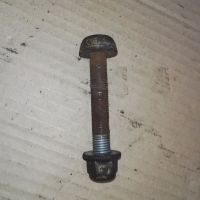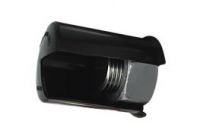The old school:
Whoever lubricates goes! We will take care of repairing old cars (bolts have been built the same for centuries, both in new and old cars - in terms of threads, the differences are at most in the heads of bolts and nuts), it is written that before installing the bolts, lubricate with grease, e.g. ŁT4. So, in the old school of mechanics, they all lubricated, grandfather on a bicycle and moped, father on a motorcycle and FSO car. For this reason, nothing has ever unscrewed by itself, it has stopped. On the other hand, there has never been a problem with unscrewing a screw, e.g. after 5 years.
New school:
Do not lubricate the threads! It is not allowed, the screw will unscrew and you will drive into the ditch. Well, safety - of course, on the safety and health of users, car manufacturers care like a dog on a bowl of milk (vide: the last folkswagon scandal). Do not lubricate it or it will fall off. Do not lubricate, because it will rot, rust and it will not be possible to unscrew in a few years and then we will sell you a whole new control arm with a subframe, because we do not have new bolts in a separate offer. :)
A compromise between the old school and the new school:
Do not lubricate the thread of the bolt before assembly (it is galvanized, not black as it used to be), only after tightening with the specified torque, make a solid cap on the head of the bolt and on the nut and protruding thread with a water-resistant grease, e.g. STP. A screw secured in this way will not rot. There will be no hydrogen pitting corrosion, which weakens the screw and may cause it to break off (and the producers say not to lubricate it, because it is galvanized - galvanizing will hydrate the surface - and the galvanization is for the lifetime of the car, that is 2 years - because then the warranty expires. It is a pity that they do not know that the average car in Poland has been struggling for 14 years). Grease (or something else, at your discretion - in the old school, it was cool to melt beef tallow, such as for smearing knots in mopik - not Silesians will translate them with a translator) coated on the head of the screw and the protruding thread will never cause a drop in friction in an already tightened screw .
And now seriously, if I did not deal with this topic for some time at the university, I would not know either. With this thread lubrication in cars and beyond, the slurry reduces the friction between the bolt and nut, which can falsify the tightening torque of the bolt. Manufacturers in their catalogs indicate the tightening torque (gibberish of the pens: torque rotary screw tightening) for dry screws without grease. The grease slightly falsifies and therefore it cannot be guaranteed that the moment measured on the screw greased with the screeds, given in the manual, will guarantee the durability of the connection. It's just about that. However, as practice shows, it is not that critical. Mechanics lubricate, especially not the thread, but the bolt itself, because they know that it will make their work easier in some time when the customer returns to the workshop.
From the AGH laboratory:
3.1. Characteristics of the basic methods of bolt tightening.
Making a bolt joint with preload requires calculating its value at the design stage and then determining the value of tension that is obtained in the bolts during the connection. Unfortunately, direct measurement of the bolt tension is difficult under normal conditions, therefore methods of indirect determination of its value by measuring other physical quantities are used.
The most common method of creating a jointwith a given value of tension, it is to apply a specific tightening torque to the nut with a torque wrench. However, this method is not very accurate, because the tightening torque does not directly determine the tension in the bolt, but is the result of the interaction of random variables. The torque fluctuations are influenced by many factors, the precise determination of which is extremely difficult or even impossible. These are, among others: static and kinetic friction, irregularity and non-perpendicularity of cooperating surfaces, lubrication , errors in the execution of the thread and mating surfaces, non-uniformity of the bolts, etc.
For standard bolts, it was determined that the spread of the tightening torque value, with the required constant initial tension, reaches ? 30%, and for flange bolts and nuts even up to ? 50%. Therefore, it is assumed that the connection can be tightened based on the tightening torque if the tolerance of the correctness of the joint execution is above ? 30% [3].
It follows that the basic problem of this tensioning method is obtaining the exact value and repeatability of the preload in the bolt joint. The main reason for the large dispersion of the preload values at a constant, even precisely selected tightening torque is the fact that the applied
the torque is 85% ÷ 90% lost to overcome frictional couplings during tightening, which occur both on the face of the tightened nut and on the thread surface.
So my slogan on this topic is: compromise.
Alone, after screwing in the screw or screwing in the nut, it smears the rags and it can always be unscrewed in years to come :)
Finally, a description for the curious only. Very accessible information for the above-mentioned issues.





